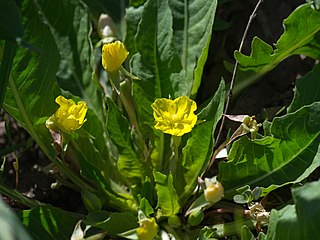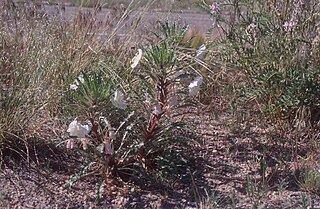
Oenothera caespitosa, known commonly as tufted evening primrose, desert evening primrose, rock-rose evening primrose, or fragrant evening primrose, is a perennial plant of the genus Oenothera native to much of western and central North America, in habitats such as talus slopes and sandy plains. It is normally night-blooming.

Neoholmgrenia andina is a species of evening primrose known by the common name Blackfoot River evening primrose. It is native to western North America, including southern Canada and much of the western United States, where it is a plant of mountains, and sagebrush plateaus. It is a small annual herb growing a hairy, branching stem generally under 15 centimeters tall. The bunched leaves are widely lance-shaped and 1 to 3 centimeters long. The inflorescence bears one or more flowers with usually four tiny bright yellow petals. The fruit is a flat capsule up to a centimeter long.

Camissonia contorta is a species of evening primrose known by the common name plains evening primrose. It is native to western North America from British Columbia to California to Idaho, where it grows in many habitat types. It is an annual herb producing a slender, bending to curling red or green stem which is sometimes hairy. It is up to 30 centimeters long and erect or spreading out. The blue-green leaves are linear to very narrowly oval in shape and up to 3.5 centimeters long. The nodding inflorescence produces one or more small flowers. Each has bright yellow petals up to half a centimeter long, sometimes with small red dots near the bases. The fruit is a capsule about 3 centimeters long containing shiny seeds.
Chylismia heterochroma is a species of evening primrose known by the common name Shockley's evening primrose. It is native to the desert slopes and woodland of eastern California and Nevada. It is a hairy, glandular annual herb growing a spindly stem up to a meter tall. There is a thick basal rosette of leaves which are mostly oval in shape and several centimeters in length, and generally no leaves higher up the stem. The inflorescence produces several small flowers with four oval petals just a few millimeters long and lavender in color with yellow-tinted bases. The fruit is a club-shaped capsule roughly a centimeter long.

Camissoniopsis lewisii is a species of evening primrose known by the common name Lewis' evening primrose. It is native to southern California and Baja California, where it grows in coastal habitat and on the grasslands of the inland mountain ranges. as an example occurrence in Baja California, C. lewisii occurs in association with Mimulus aridus and Adiantum jordanii.
Tetrapteron palmeri is a species of evening primrose known by the common name Palmer evening primrose. It is native to the western United States from California to Idaho, where it grows in several habitat types, including desert and sagebrush. It is a roughly hairy annual herb growing in a low patch on the ground, generally with no stem. The leaves are widely lance-shaped and up to about 5 centimeters long, with a few small teeth along the edges. The nodding inflorescence produces flowers with yellow petals only 2 or 3 millimeters long each and a noticeable bulbous stigma tip which may be up to a centimeter wide. The fruit is a leathery capsule around half a centimeter long with small wings near the tip.

Taraxia subacaulis is a species of evening primrose known by the common name diffuseflower evening primrose. It is native to the western United States, where it grows in several habitat types, especially in mountainous areas. It is a fleshy perennial herb growing from a taproot and usually lacking a stem. The leaves are lance-shaped to oval and up to 22 centimeters long and are borne on long petioles. The flower has yellow petals, each up to 1.5 centimeters long, and a large, bulbous stigma tip. The fruit is a leathery capsule 1 to 3 centimeters long.

Taraxia tanacetifolia is a species of evening primrose known by the common name tansyleaf evening primrose. It is native to the western United States, particularly the Great Basin and the mountains of the Pacific Northwest. It is a perennial herb growing from a woody taproot and spreading via lateral shoots. It lacks a stem and takes the form of a flat rosette of hairy leaves with a central inflorescence. The frilly leaves are long and narrow, lined with deep, irregular, narrow lobes. The leaf blades are up to about 30 centimeters long and are borne on long petioles. The flowers at the center of the rosette have bright yellow petals up to about 2.3 centimeters long. The fruit is a swollen, leathery capsule containing two rows of seeds.
Epilobium foliosum is a species of flowering plant in the evening primrose family known by the common names leafy willowherb and California willowherb. It is native to parts of western North America from British Columbia through California to Arizona, where it grows in many types of habitat, including disturbed areas.
Epilobium pallidum is a species of flowering plant in the evening primrose family known by the common name largeflower spike-primrose. It is native to western United States, where it grows in moist areas in northern California, Oregon, and Idaho. It is an annual herb producing a narrow, upright stem up to 60 centimeters long lined with narrow oval leaves each up to 5 centimeters in length. The inflorescence atop the stem bears several flowers and hairy, leaflike bracts. Each flower has four bilobed petals each up to about a centimeter long and bright pink in color. The fruit is a beaked capsule between 1 and 2 centimeters long containing a row of tiny seeds.

Epilobium siskiyouense is a rare species of flowering plant in the evening primrose family known by the common names Siskiyou willowherb and Siskiyou fireweed.

Ludwigia repens is a species of flowering plant in the evening primrose family known by the common name creeping primrose-willow. It is native to parts of the Americas and it has the potential to spread easily and become naturalized in many areas. It is known as an aquatic weed in some regions. It is also cultivated as an aquarium plant. This is a mat-forming perennial herb with a creeping stem up to 30 centimeters long, rooting at nodes which come in contact with wet substrate. The leaves are oppositely arranged and up to 4 or 5 centimeters long. The flower has four yellow colored petals no more than 3 millimeters long nested on a base of four pointed sepals which may be slightly longer.

Oenothera californica, known by the common name California evening primrose, is a species of flowering plant in the evening primrose family.

Oenothera glazioviana is a species of flowering plant in the evening primrose family known by the common names large-flowered evening-primrose and redsepal evening primrose. Oenothera lamarckiana was formerly believed to be a different species, but is now regarded as a synonym of Oe. glazioviana.

Oenothera laciniata is a species of flowering plant in the evening primrose family known by the common name cutleaf evening primrose. It is native to the eastern United States but it can be found in many other places as an introduced species and sometimes a noxious weed. It is reported from Hawaii, Australia, Britain, France, Korea, Japan, and other areas. This is an annual or short-lived perennial herb producing a spreading stem from a hairy rosette of deeply cut or lobed leaves. Flowers occur in the axils of leaves higher on the stem. Each flower has pale to deep yellow petals up to about 2 centimeters long which fade orange, pink, or red with age. The fruit is a cylindrical capsule up to 5 centimeters in length.

Oenothera longissima is a species of flowering plant in the evening primrose family known by the common name longstem evening primrose. It is native to the southwestern United States, where it grows in relatively moist areas in scrub and woodland habitat. This is a biennial herb producing a tall, erect stem known to well exceed 2 meters in height. The widely lance-shaped leaves may be 22 centimeters in length and may have slight teeth along the edges. The inflorescence is a spike of showy large flowers. Each has yellow petals which may be more than 6 centimeters in length and fade orange or red with age. The fruit is a lance-shaped capsule up to 5.5 centimeters long.

Oenothera primiveris is a species of flowering plant in the evening primrose family known by the common names yellow desert evening primrose, bottle evening-primrose, and desert evening-primrose.

Oenothera wolfii is a rare species of flowering plant in the evening primrose family known by the common name Wolf's evening primrose. It is native to the coastline of southern Oregon and northern California, where it grows in coastal prairie, dunes, and coastal forest and woodland habitat. As of 1997 it was known from only about 16 occurrences. The biggest threat to the plant is its easy hybridization with its relative and probable descendant, Oenothera glazioviana. As this rare wild plant crosses with the introduced garden escapee, introgression occurs, causing what is known as genetic pollution; fewer pure individuals of O. wolfii will be seen as they are outnumbered by hybrids.
Oenothera xylocarpa is a species of flowering plant in the evening primrose family known by the common name woodyfruit evening primrose. It is native to the Sierra Nevada of California, its range extending just into western Nevada. It grows in coniferous forest and meadow habitat, often in soils rich in pumice and other gravel. It is a perennial herb growing from a thick taproot and producing a flat, dense rosette of hairy, gray-green leaves. There is no stem. The showy flowers appear amidst the leaves. Each has four petals which may be nearly 4 centimeters long, bright yellow in color, fading pink to red with age. The fruit is a straight, curving, or twisting capsule which may be up to 9 centimeters long.

Oenothera harringtonii is a species of flowering plant in the evening primrose family known by the common names Arkansas Valley evening primrose and Colorado Springs evening primrose. It is endemic to the state of Colorado in the United States.















